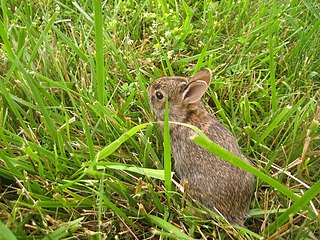
During the late fourteenth century, rabbit came into usage as a term for the young of the coney, which is what people used to call rabbits. In Middle English, the word was rabet or rabette. The Middle English word likely came from the Old Northern French robète, which may derive from the Flemish/Middle Dutch robbe. The trail ends with robbe. Its origins are unknown. By the nineteenth century, rabbit replaced coney as the name for adults of the species. Why did coney give way to rabbit? Coney, originally pronounced to sound like money, became a punning synonym for the vulgar, British slang term cunny. Coney appears twice in the King James Bible (Leviticus 11:5 and Deuteronomy 14:7). To avoid the vulgar homophone, the pronunciation of coney moved to a long o to rhyme with stoney.
Compare the passages from the King James version with the New International Version.
KJV: Leviticus 11:5 And the coney, because he cheweth the cud, but divideth not the hoof; he is unclean unto you. 6 And the hare, because he cheweth the cud, but divideth not the hoof; he is unclean unto you.
NIV: Leviticus 11:5 The hyrax, though it chews the cud, does not have a divided hoof; it is unclean for you. 6 The rabbit, though it chews the cud, does not have a divided hoof; it is unclean for you.
KJV: Deuteronomy 14:7 Nevertheless these ye shall not eat of them that chew the cud, or of them that divide the cloven hoof; as the camel, and the hare, and the coney: for they chew the cud, but divide not the hoof; therefore they are unclean unto you.
NIV: Deuteronomy 14:7 However, of those that chew the cud or that have a divided hoof you may not eat the camel, the rabbit or the hyrax. Although they chew the cud, they do not have a divided hoof; they are ceremonially unclean for you.
Notice the substitutions of hyrax for coney and rabbit for hare in the modern translation. Rabbits and hares are different. They are not interchangeable. While both rabbits and hares are in the family Leporidae, hares are in the genus Lepus and rabbits are divided among several genera. (More on the confusion between rabbits and hares later.) Hyraxes, in case you’re curious, are small, herbivorous mammals. Also known as rock badgers, hyraxes range across the Middle East and Africa. The Hebrew word for them is shaphan. Although hyraxes appear similar to rodents, the similarities are superficial as the hyrax is closer to elephants and manatees on the evolutionary tree.

Hare (1502) by Albrecht Dürer (1471–1528).
So where do the words coney and hare come from? Coney’s usage dates from 1150 to 1200 and derives from the Middle English word conyes (or conies) which comes from the Old French word conis (plural of conil), which derives from the Latin cunīculus, meaning rabbit or burrow. Evidence suggests the word’s origin is Iberian and fits with evidence that rabbits spread to Europe through northwest Africa and the Iberian peninsula. Hare comes from the Old English word hara, meaning hare. Hara derives from the West Germanic word *hasan-, whose origin is uncertain but may have originally meant gray. Because rabbits are not original to northern Europe, there is no Germanic name for them.
So you think you know what a rabbit is? Keep your ears pricked and let the confusion begin. Hares do not dig burrows. They make shallow nests in grass. When born, their young have fur and their eyes are open, ready to fend for themselves. The young of rabbits are born in the protection of burrows and are blind and hairless at birth. Hares do not usually live in groups while rabbits live in warrens. Hares are larger than rabbits, have longer ears, and a jointed skull. Hares possess 48 chromosomes to the rabbit’s 44. Sounds straightforward. However, the jackrabbit is not a rabbit. It’s a hare. The Belgian hare is not a hare, it’s a domestic rabbit bred to look like a hare. The cottontail rabbit is a rabbit, however, the cottontail acts like a hare, living in above-ground nests.
The word jackrabbit is a shortened form of jackass-rabbit, from the mid-nineteenth century. Some people, Mark Twain among them, thought the long ears resembled those of a donkey.
We have an animal here whose surname is the “jackass rabbit.” It is three feet long, has legs like a counting-house stool, ears of monstrous length, and no tail to speak of. It is swifter than a greyhound, and as meek and harmless as an infant.
—Mark Twain in “Doings in Nevada,” New York Sunday Mercury, February 7, 1864.[The “jackass rabbit”] He is well named. He is just like any other rabbit, except that he is from one-third to twice as large, has longer legs in proportion to his size, and has the most preposterous ears that ever were mounted on any creature but the jackass.
—Mark Twain in Roughing It, 1872.
Attribution: Baby Rabbit by Siddharth Patil (Own work) [CC0], via Wikimedia Commons. Albrecht Dürer [Public domain], via Wikimedia Commons.


Well, I learned a lot about rabbits, coneys and those jumpers called Jack Rabbits. Thanks for all the information. I enjoyed reading this today.